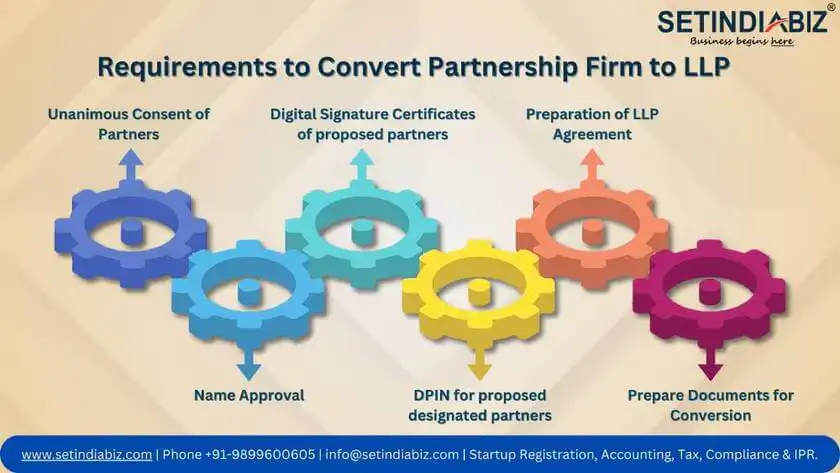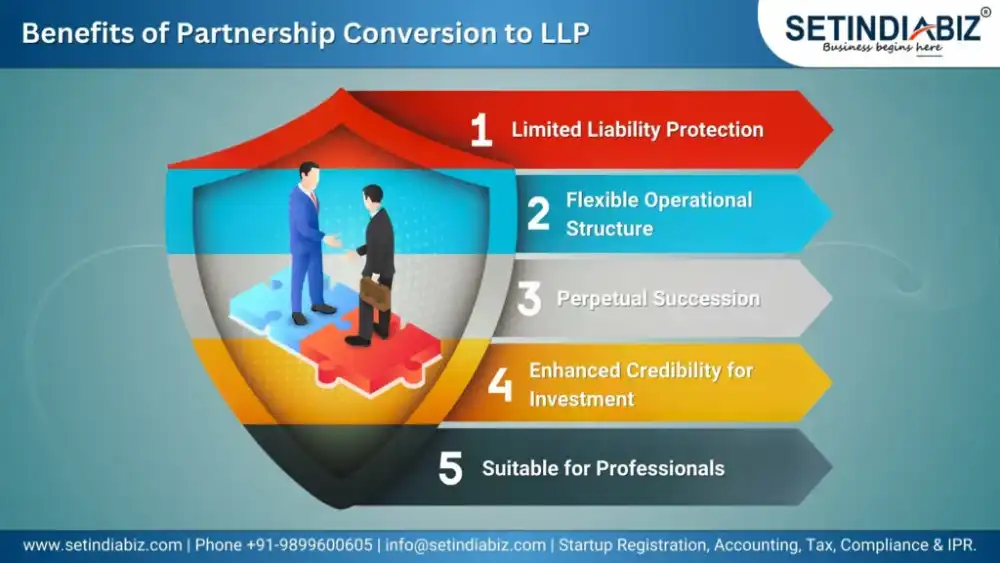How Can You Convert a Partnership Firm into an LLP?
Overview : Go through the blog thoroughly to understand every aspect of partnership to llp conversion. This includes its benefits, liabilities, procedure, and documents involved. Whether you’re looking to gain liability protection as a partner or grant perpetual succession to your business, conversion of partnership firm into LLP is the way to go! Need professional Assistance in how to convert partnership firm into LLP? Consult Our Experts!
Limited Liability Partnerships (LLPs) have become more popular in recent years as an alternative to conventional partnership structures. This is because LLPs provide several additional benefits like flexibility in management, no maximum limit on the number of partners, distinct legal identity of the business, low compliances, and so on.
As far as the partners are concerned, they benefit from the restrictions placed on their liabilities, in contrast to the partners of a traditional partnership firm. Moreover, the risk of loss in respect to their personal assets is lifted. So, if you want to go for conversion of partnership firm into an LLP, you hardly have any reason not to do so! Before we dig deeper into the benefits and procedure of partnership to LLP conversion, let’s understand what a Limited Liability Partnership is.
What is a Limited Liability Partnership?
Limited Liability Partnerships are governed under the LLP Act of 2008. These structures were introduced to overcome the flaws of traditional Partnership Firms. For instance, contrary to firms, LLPs have a distinct legal identity due to their mandatory need for incorporation.
Moreover, the incorporated entity, despite being a Partnership structure, offers benefits like limited liability for partners and a continued existence of the business akin to companies. LLPs are said to combine the best features of both worlds, companies as well as partnerships. Our detailed comparison further will help you understand better!
Being a Partnership structure at the core, the foundation of an LLP is laid by a mutual agreement signed between the partners. This agreement is further validated by a public notary when the document is stamped and the concerned stamp duty is paid for the purpose.
The agreement contains all the terms and conditions mutually agreed between partners, including their capital sharing ratio, profit share in the business, and fixed liabilities. Besides, governance procedures like admitting new partners, removing existing partners, and so on are also carried out following the terms of the agreement itself.
Why Prefer LLP Over Partnership Firm?
When considering the strategic move of partnership firm to LLP conversion, it’s imperative to understand the distinct advantages that the latter has to offer. Limited Liability Partnerships (LLP) outshine traditional partnerships in multiple ways. Be it incorporation, day-to-day management, taxation, or compliance, LLPs is the best structural choice to opt for, provided you’re starting a business in Partnership. The table below, highlighting the difference between LLP and Partnership Firm will give you a clearer picture!
| Feature | LLP | Partnership Firm |
|---|---|---|
| Flexibility and Freedom of Management | LLP partners enjoy significant freedom in day-to-day operations due to flexible LLP Agreement drafting under the Limited Liability Partnership Act of 2008. | Partnership firms operate under a more rigid structure, with fewer options for customization in managing daily activities. |
| Permanent Succession | The demise or departure of a partner does not impact LLP operations, thanks to its ability to function as a separate legal entity, ensuring continuity. | Partnership firms face disruptions in operations when a partner departs or passes away, impacting the business’s stability and succession. |
| Attracts Investments | LLPs attract foreign investors and venture capitalists due to their organized structure, resembling body corporates, creating a favorable environment for investment. | Partnership firms may face challenges in attracting foreign investment, as their structure may be perceived as less organized and more traditional. |
| Multidisciplinary Collaboration | LLPs facilitate collaboration among professionals from different fields, fostering a multidisciplinary approach for achieving diverse business goals. | Partnership firms may lack the flexibility to easily collaborate across disciplines, limiting the range of goals they can effectively pursue. |
| Legal Liability | LLP partners enjoy limited liability, protecting personal assets from business debts. | In partnership firms, partners have unlimited liability, risking personal assets to settle business debts. |
Requirements for Partnership to LLP Conversion
Before undertaking the process to convert partnership firms into LLPs, it is crucial to understand the fundamental prerequisites that must be fulfilled. Meeting these prerequisites lays the foundation for a systematic and legally compliant conversion process, ensuring the accurate formation of LLP by the LLP Act, 2008. If you need any assistance in meeting these requirements, talk to our consultants for accurate guidance. Refer to the list below for detailed information.

- Unanimous Consent of Partners: Ensure unanimous consent from all partners of the existing partnership firm for the conversion into an LLP. Alignment among partners is essential for a smooth transition.
- Name Approval: Undergo the name approval process with the Ministry of Corporate Affairs (MCA) for the proposed LLP. Choose a name that adheres to MCA guidelines for naming LLPs, distinguishing it from other existing businesses.
- Digital Signature Certificates of proposed partners: Confirm that all partners of the proposed LLP possess Digital Signature Certificates (DSC). DSCs facilitate the authentic submission of various documents during the process of partnership to llp conversion.
- DPIN for proposed designated partners: Unlike Partnership firms where all partners are collectively responsible for managing the day-to-day affairs, partners in LLP appoint designated partners for the purpose. The proposed designated partners must obtain their DPIN for unique identification from the MCA.
- Preparation of LLP Agreement: Draft a comprehensive LLP Agreement outlining the roles, responsibilities, and profit-sharing ratios among partners. The LLP Agreement must comply with the provisions of the Limited Liability Partnership Act of 2008. Moreover, it must be signed by all proposed partners and stamped by a public notary.
- Prepare Documents for Partnership to LLP Conversion: Prepare the necessary documents, including Form 17 (Application and Statement for conversion) and Form FiLLiP (Application for Incorporation of an LLP). These documents require detailed information on the firm’s name, address, registration details, partners’ details, and capital contributions.
Convert Partnership Firm to LLP Process
Name Approval of Proposed LLP
Register and log in to the MCA portal. You must choose the “RUN – LLP” option under the MCA Services menu. Reserve Unique Name is referred to as RUN. From the dropdown list the “Conversion of Firm into LLP” option must be chosen. A form appears where you have the option to propose two names.
Along with that, you can submit any supporting documents asked for, in their digital formats. Finally, submit the form with the prescribed application fees of Rs.200. Once your name is reserved, it shall be valid for 90 days, within which the partnership to llp conversion process must be completed.
Obtaining DSCs of all Partners
It is ideal that all partners of an LLP possess Digital Signature Certificates in their names. This is because almost every e-form and document filed during the partnership to LLP conversion process requires the DSC of the partners for authentication. DSCs are the electronic equivalent of the partner’s physical signatures, promising more security and privacy. You can apply for DSCs with our assistance. For more information, consult our experts today!
Obtaining DPINs of all Designated Partners
Besides DSC, proposed designated partners must apply for their Designated Partners Identification Number (DPIN). This unique number is a mandatory requirement for their appointment in the LLP. You can only convert partnership firm into LLP, if you have 2 proposed designated partners readily possessing their DPIN. In order to obtain the DPIN, an application is filed online on the MCA website , with documents like PAN, Adhar, and address proofs of proposed designated partners.
Apply for Partnership to LLP Conversion
The next step is to apply for Partnership Firm to LLP conversion. For this purpose, two crucial forms are needed to be filed to the Registrar of Companies (ROC) consequently. The first one is the application and statement for conversion in Form 17 and the second one is the application for incorporating the converted LLP in Form FiLLiP.
Information required to be entered in form 17 include the following:
- RUN – LLP form Service Request Number (SRN).
- The proposed LLP’s name.
- Details of the firm’s name, address, registration, and partnership agreement.
- Information on the number of partners and the required capital contribution.
- Details on secured creditors.
Information required to be entered in form FiLLiP include the following:
- Information on the RUN – LLP will be automatically filed.
- The LLP’s registered office address and email address.
- The Registrar’s Office.
- Nature of commercial operations
- Details of the partners and designated partners like their PAN, DPIN, and DIN.
- Contributions of each partner to the LLP.
The proposed partners must digitally sign both forms using their DSCs obtained in the earlier step. Besides, an independently practicing CA, CS, or CMA must verify the information submitted and certify the forms as well. The application fee shall depend on the authorized capital of the converted LLP. We will discuss the other attachments submitted with the forms in the further sections of this blog.
Issue of Registration Certificate
After the submission of the applications, the RoC examines them thoroughly. Only after he is satisfied with the authenticity of the details and documents provided, he shall issue a Certificate of Registration in the name of the converted LLP. This Certificate shall conclusively prove the legal existence of this structure. If the application filed is found to be incorrect or incomplete, the Registrar shall deny registration, and the applicant will have to file a fresh application with correct and adequate information again.
Filing LLP Agreement
The process of Incorporating the LLP, does not end with the issue of Certificate of Registration. Within 30 days from the date of registration, the applicant must file the LLP Agreement to the RoC in Form-3. The LLP agreement, containing the terms and conditions mutually agreed between partners, must include the following information:
- Name of the LLP
- Names of all the partners and designated partners
- Capital and profit-sharing ratios
- Rights and obligations of partners
- Rules regarding the day-to-day operations of the LLP
Intimation to the Registrar of Firms
Within 15 days from the date of incorporation, Form 14 must be submitted to the state’s Registrar of Firms where the previous Partnership Firm was located. This will act as an intimation that the partnership to LLP conversion is now in effect and the older Partnership Firm no longer exists. The form must be submitted with a copy of the incorporation certificate received by the converted LLP, along with the copy of other incorporation documents, like the LLP Agreement.
Docs Needed for Partnership to LLP Conversion
Undertaking the journey to convert a partnership firm to a Limited Liability Partnership (LLP) involves meticulous documentation to ensure a seamless and legally compliant transition. The process of conversion of partnership firm into LLP, encapsulated in Forms 17 and FiLLiP and subsequent intimation in Form 14, demands the submission of specific documents.
This ensures transparency, and regulatory adherence, and sets the stage for the enhanced operational framework of an LLP. The completeness and accuracy of these documents not only facilitate a smooth partnership to LLP conversion but also pave the way for the new LLP’s compliance with regulatory requirements. Get the complete list of documents in the table below.
| Forms | List of Documents Required |
|---|---|
| Forms |
|
| Form FiLLiP |
|
| Form 14 |
|
Benefits of Conversion of Partnership Firm into LLP
The journey of conversion of partnership firm into LLP opens the door to a range of benefits, reshaping its organizational landscape. These benefits transcend legal and operational realms of a conventional partnership. Here are five key benefits that underscores this strategic process

- Limited Liability Protection: One of the primary advantages lies in the limited liability protection offered by an LLP. Unlike a traditional partnership, where personal assets are at risk, an LLP shields the personal assets of partners from business liabilities. This safeguard is a crucial factor in attracting partners who seek reduced personal risk.
- Flexible Operational Structure: LLPs provide partners with a considerable degree of flexibility in managing day-to-day operations. The Limited Liability Partnership Act of 2008 does not impose strict guidelines on the drafting of the LLP Agreement, allowing partners the freedom to customize the operational structure based on the specific needs and goals of the business.
- Perpetual Succession: The concept of perpetual succession distinguishes LLPs from traditional partnerships. In an LLP, the departure or demise of a partner does not disrupt the continuity of the business. The LLP operates as a separate legal entity, ensuring continuity and stability irrespective of changes in partner composition.
- Enhanced Credibility for Investment: LLPs present an attractive proposition for foreign investors and venture capitalists. The organized structure and similarities to body corporates make LLPs an appealing investment opportunity. The transparent operational framework and limited liability aspects enhance the credibility and attractiveness of an LLP to potential investors.
- Suitable for Professionals: LLPs facilitate collaboration among professionals from diverse disciplines and fields. This multidisciplinary approach allows professionals with varied expertise to come together and work towards common goals. The ability to pool skills and resources from different domains contributes to the overall effectiveness and innovation within the LLP.
FAQ's
1.What are the benefits of converting a partnership firm into an LLP?
2.Why is LLP preferable over a Partnership Firm?
3.What is the process of converting a partnership firm into LLP?
4.What documents are required for partnership to LLP conversion process?
5.How long does the partnership to LLP conversion process take?
Author Bio

Editorial Team | in
Setindiabiz Editorial Team is a multidisciplinary collective of Chartered Accountants, Company Secretaries, and Advocates offering authoritative insights on India’s regulatory and business landscape. With decades of experience in compliance, taxation, and advisory, they empower entrepreneurs and enterprises to make informed decisions.
Related Articles :
- Conversion of LLP Into Company
- Stamp Duty on Partnership Deed
- Create Rent Agreement Online
- What is the Difference Between LLP and Partnership Firm
- What is the Process of LLP Registration in India
- What is the Process of LLP Registration in India
- Benefits of Limited Liability Partnership
- LLP Agreement, Its Content & Draft Format
